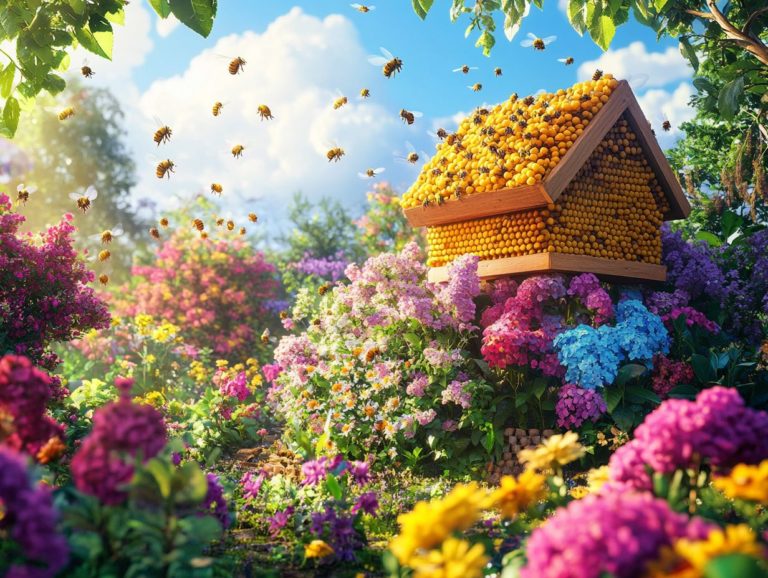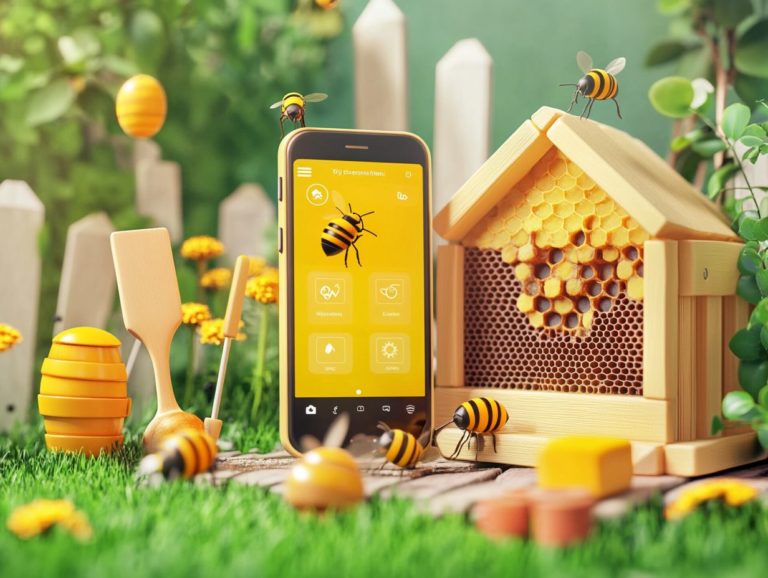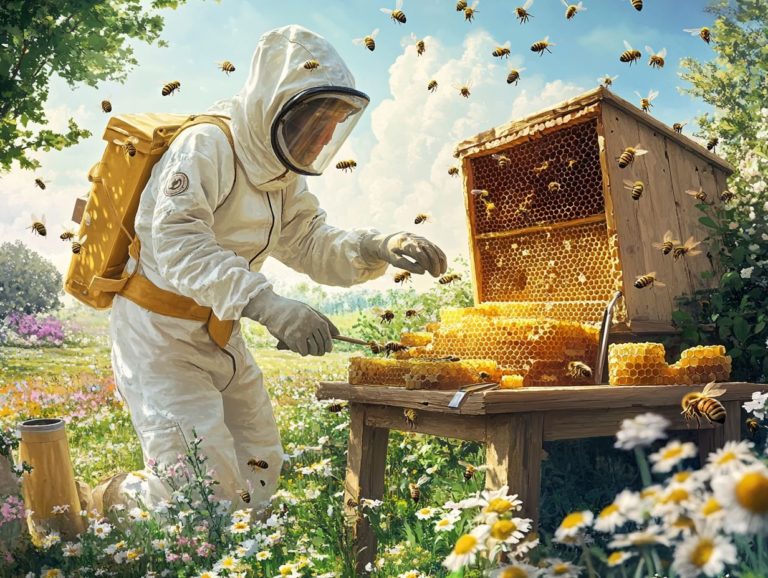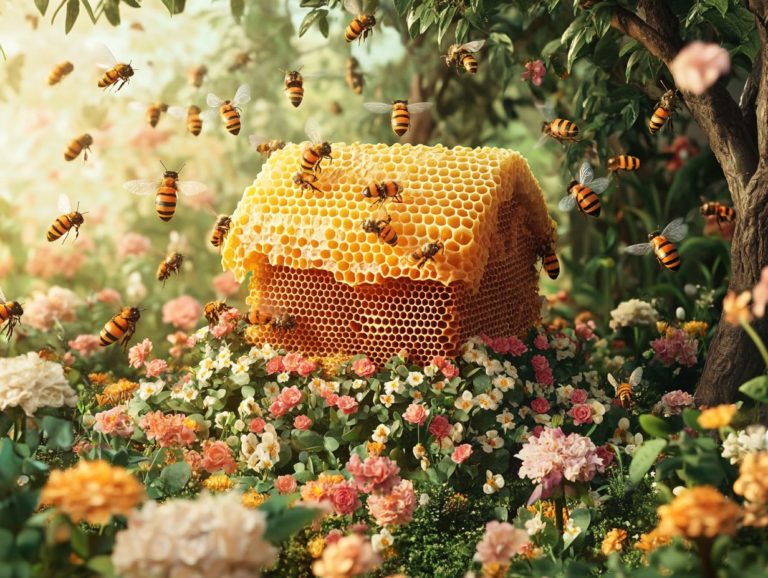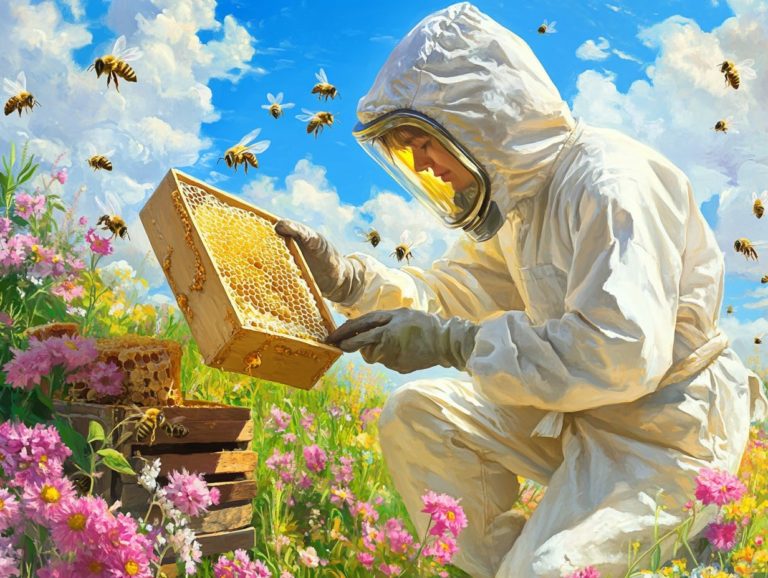The Basics of Hive Rotation
Are you ready to boost your bee colony’s health and honey production? Hive rotation might just be your secret weapon! Hive rotation is an essential practice in beekeeping that plays a vital role in maintaining healthy and productive colonies. By grasping the concept of hive rotation and its significance, you can greatly enhance the well-being of your bees and optimize honey production. This technique is particularly beneficial for backyard and commercial beekeeping alike, offering a flexible approach to managing your bee colony.
This article delves into the fundamentals of hive rotation, exploring its benefits and the most effective times and methods for implementation. It also covers common pitfalls and alternative strategies to ensure that your hives flourish in any environment, especially considering environmental issues and the diverse needs of backyard hives.
Contents
Key Takeaways:
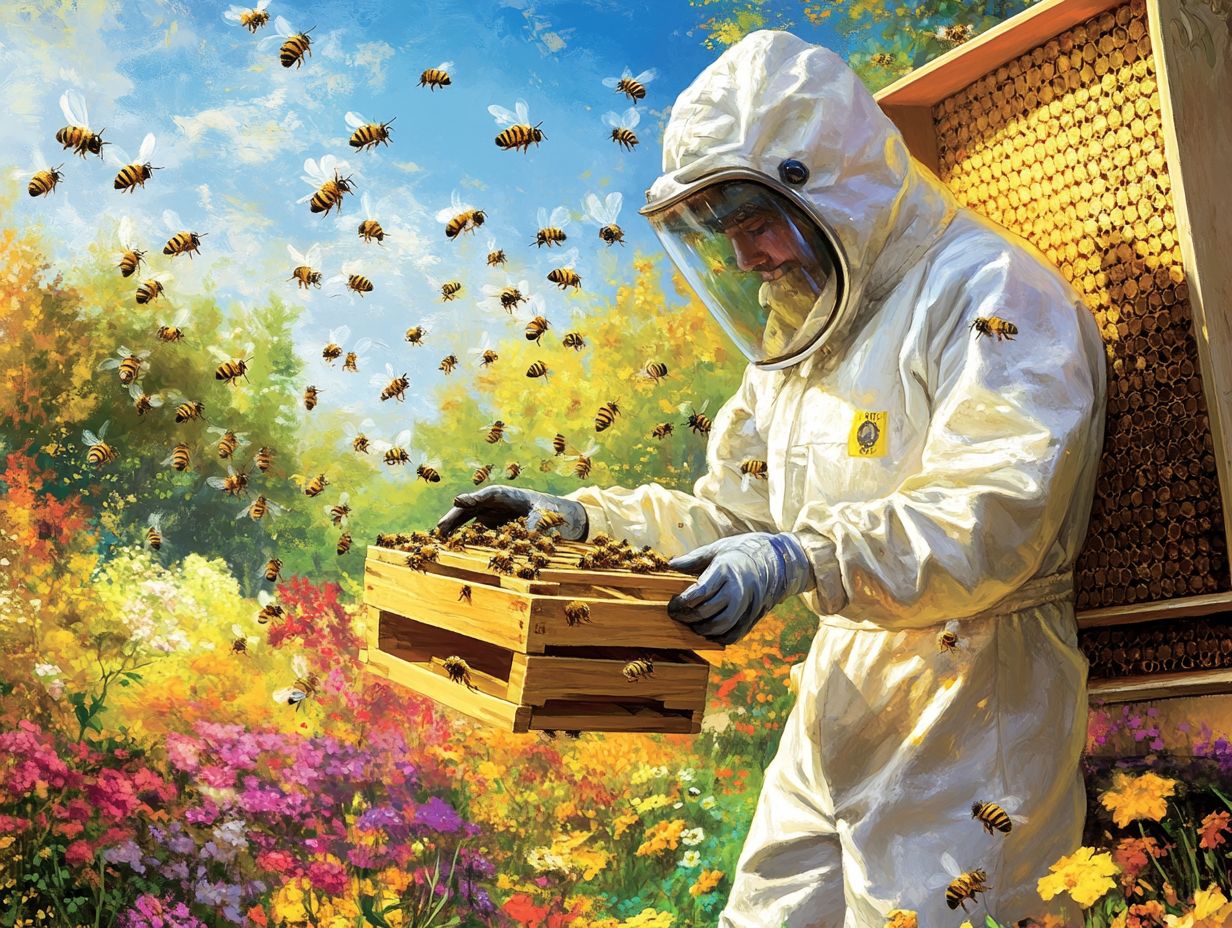
- Regular hive rotation promotes the health and productivity of bee colonies.
- Effective hive rotation involves assessing hive health, planning a rotation strategy, and monitoring the hives during and after rotation.
- Maintaining healthy hives during rotation requires providing adequate food and water, monitoring for pests and diseases, ensuring proper ventilation and spacing, and employing effective beekeeping equipment.
What Is Hive Rotation?
Hive rotation is a sophisticated beekeeping technique that allows you to strategically reposition your hives, optimizing honey production while enhancing the health of your bee colonies and effectively managing environmental factors.
By employing this method, you ensure your colonies are exposed to a variety of flora (flower sources), which is vital for nectar gathering (collecting sweet liquid from flowers) and pollen collection (gathering the powdery substance from flowers) two critical elements for the health of the brood box and the overall well-being of the Queen bee. This flexibility is especially useful for backyard beekeeping, where space and flora diversity might be limited.
Not only does hive rotation grant your bees better access to essential resources, but it also significantly reduces the risk of diseases and pests, helping keep your hives comfortable and thriving!
Why Is Hive Rotation Important?
Hive rotation is essential for a multitude of reasons, primarily because it significantly boosts honey production. By strategically placing hives in the most favorable flower sources, you can optimize the health and growth of your bee colony.
Environmental factors can greatly influence hive health, so employing rotation becomes a vital strategy to ensure your hives are situated in locations that offer optimal nectar-gathering opportunities throughout the seasons. This practice paves the way for successful beekeeping and cultivates effective hive management, reducing the risk of diseases and pest infestations.
What Are The Benefits Of Hive Rotation?
Hive rotation is a cornerstone of effective hive management and swarm prevention, ensuring your colonies remain robust and productive. The benefits of hive rotation in beekeeping are extensive, offering you improved honey production and enhanced colony health.
By strategically rotating your hives, you can optimize conditions for the brood box, ensuring that your Queen bee has a prime environment to lay her eggs, filled with abundant resources and minimal stress. This practice significantly reduces the risk of overcrowding, promoting healthier hives that can thrive over the long term.
In fact, studies have shown that a well-planned hive rotation can lead to honey production increases of up to 20%, showcasing its effectiveness in maximizing resource utilization. Healthier colonies exhibit improved resistance to diseases and pests, ultimately resulting in lower mortality rates and extended lifespans for your bees.
This proactive management approach not only enhances your yield but also mitigates the risks associated with unpredictable environmental changes and health crises in the apiary, allowing you to enjoy a more successful and sustainable beekeeping journey.
Start implementing these hive rotation techniques today to see the benefits for your bees!
When Should You Rotate Your Hives?
Determining the optimal timing for hive rotation is crucial for maintaining bee health and maximizing honey production, particularly during seasonal management practices. You should consider rotating your hives at strategic intervals, such as at the onset of the nectar flow season or after completing hive inspections to assess the conditions of your bee colonies.
Pay close attention to factors like hive location and environmental changes, as these will guide your decisions about when to implement hive rotation. Seasonal changes significantly influence bee activity; they thrive during the warmer months when flowers are in bloom, but their activity tends to drop in the colder seasons.
Ensuring that you rotate your hives when flowers are abundant can provide a substantial boost to honey production. Evaluate nectar availability regularly, as fluctuations can signal optimal times for rotation. Regularly checking your bee colonies is key to their success!
Signs of stress or disease may require you to rotate earlier or seek additional treatments. By monitoring bee behavior and conducting thorough inspections, you can gain valuable insights, enabling you to make timely adjustments that enhance your hive management strategies.
How To Rotate Your Hives?
Successfully rotating your hives demands a well-planned process that integrates planning, assessment, and execution, all aimed at safeguarding the well-being of your bee colonies while enhancing the efficiency of your beekeeping operations.
Begin with detailed hive checks to assess the health of each colony. This allows you to pinpoint ideal new locations that facilitate accessibility and ensure adequate resource availability for winter preparation.
Once armed with this vital information, develop a strategic plan for relocating your hives one that minimizes stress for the bees and maximizes the advantages offered by their new environment.
Step 1: Assess the Health of Your Hives
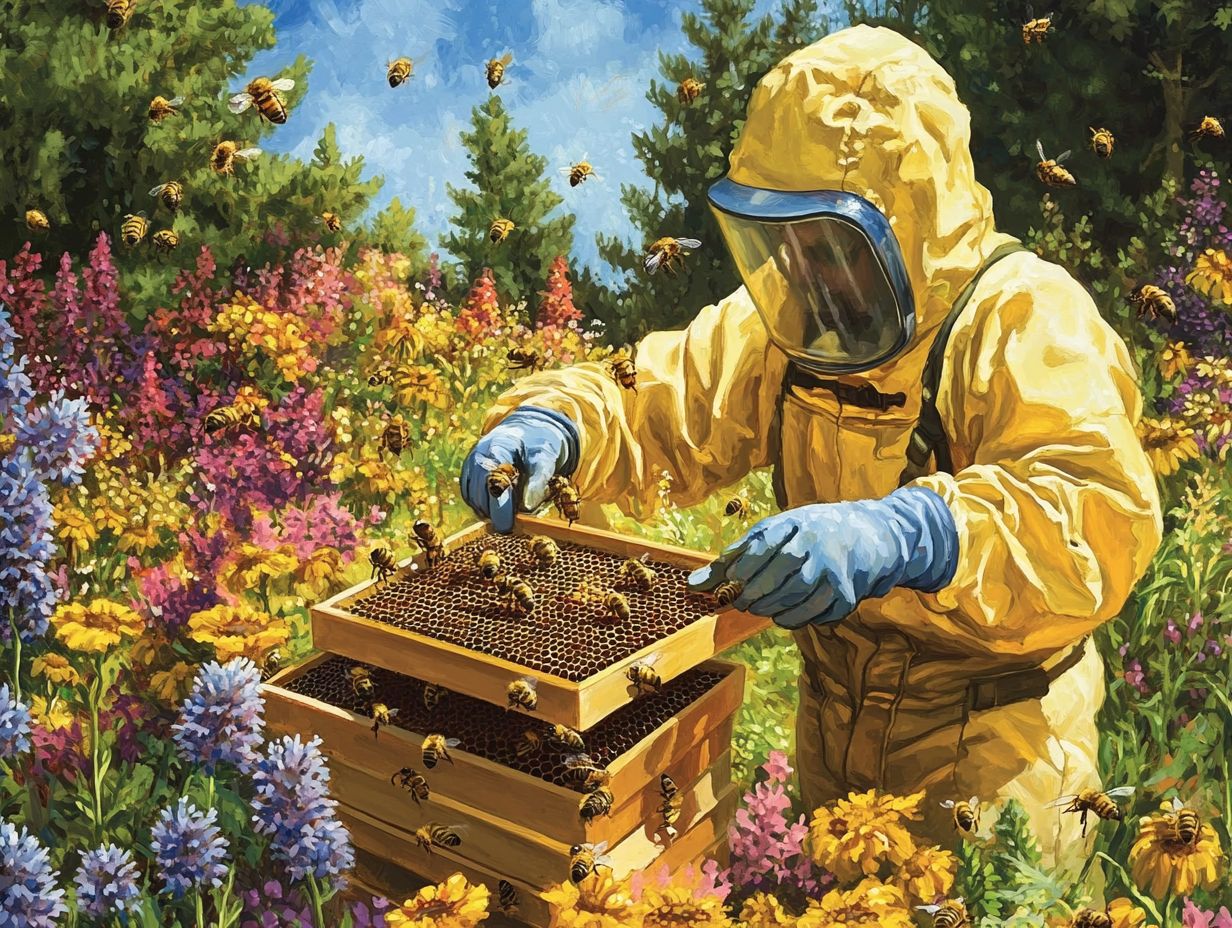
Assessing the health of your hives is the essential first step in the hive rotation process, ensuring that each bee colony is thriving before you even consider relocating them. During your inspection, examine the brood frames for any signs of disease, check the Queen bee’s productivity, and pay attention to the overall behavior of the bees, which should indicate a healthy and active colony.
Use good inspection techniques to spot any potential problems before they affect your hive. To conduct a thorough evaluation, utilize specific tools like a hive tool for prying apart the frames, a smoker to keep the bees calm, and a bee suit to ensure your safety throughout the process.
Observing the presence of Varroa mites (tiny pests that harm bees), checking that food stores are sufficient, and assessing the bees’ temperament are all vital indicators of hive health. Using frames that are easy to inspect makes the process quicker and less stressful for everyone.
Best practices also include maintaining a consistent inspection schedule and handling the frames gently to minimize disturbance. Using the right beekeeping equipment not only makes your inspections more efficient but also fosters a healthier colony environment, ultimately contributing to the successful management of your bee populations.
Participating in a local bee club can also provide valuable community feedback and beekeeping advice, enhancing your overall beekeeping success. Check for signs of stress or disease immediately to ensure your bees stay healthy!
Get started on your hive rotation today to boost your bees’ health and honey production!
Step 2: Plan Your Hive Rotation Strategy
Effective hive rotation strategies often incorporate various beekeeping techniques to ensure optimal outcomes.
When planning your hive rotation strategy, consider factors like managing your bee yard, optimal hive location, and environmental conditions. Your goal should be to identify locations that offer better access to nectar sources while minimizing potential environmental challenges for your bee colonies.
A well-crafted strategy can lead to increased honey production and healthier bee populations. Engage with a bee club to gain additional insights and support in developing your strategy.
As you develop this strategy, it s crucial to factor in seasonal flower availability to ensure your hives are positioned in areas where forage is plentiful throughout the seasons. Analyzing past hive performance will provide valuable insights into which locations yield the best results.
Effective apiary management demands flexibility, allowing you to adapt as environmental data evolves. Build a network with fellow beekeepers to share knowledge and tips! By fostering a collaborative network of shared knowledge, you can enhance both the sustainability of local bee populations and your overall honey yield.
Step 3: Prepare the New Location for Your Hives
Preparing the new location for your hives is a pivotal step in the hive rotation process. This ensures that your bees have an ideal environment in which to thrive.
As you set up the new location, consider factors such as hive design, accessibility, and proximity to nectar sources. Properly preparing this location well will directly boost your bees’ success!
Select a site that enjoys ample sunlight throughout the day, ideally facing southeast. This orientation helps the bees warm up early in the morning, setting them up for success.
Opt for an area that provides shelter from strong winds and heavy rainfall to protect your hives from harsher elements. Ensure good accessibility to the location for regular inspections and maintenance, allowing for smooth movement around the site.
Arrange the hives to maximize exposure to nearby foraging areas to boost productivity while promoting healthy air circulation among the colonies. This thoughtful approach ultimately leads to the better overall wellbeing of your bees.
Incorporating natural design elements in the hive layout can also contribute to the health and efficiency of the bee colony.
Step 4: Move the Hives
Moving hives is a critical step that requires careful planning and safe bee handling techniques to ensure the well-being of your colonies.
Moving the hives requires a delicate touch to guarantee safe bee handling and minimize stress on the colonies during the hive rotation process.
As a beekeeper, use the proper equipment and carefully relocate each hive to its new prepared location. Ensure that everything remains stable and secure during transport.
Time your hive relocation carefully; doing it during cooler parts of the day keeps your bees calm and protects your hard work!
Consider donning protective gear, like gloves and veils, to lower the chances of bee stings. It s crucial to use sturdy straps or ropes to secure the hives, preventing any jostling that could disturb your buzzing companions.
Close off the entrances during transit to keep the bees contained and less agitated. Ideally, plan the relocation when foraging activities (when bees search for food) are at their lowest, usually in the early morning or late evening, to ensure both the bees and yourself remain safe and comfortable throughout the process.
Step 5: Monitor the Hives
Monitoring your hives after hive rotation is crucial for assessing the success of the move and ensuring your bee colonies adapt well to their new surroundings. This is a key aspect of good hive care that can improve bee health and overall productivity. Pay close attention to bee behavior, brood development, and overall hive activity to evaluate the effectiveness of the hive rotation.
Consider important factors like hive location, bee entry points, and potential environmental issues that could impact your colony. Regular inspections will help you catch any potential issues early, allowing for timely interventions. Use proper inspection techniques to assess everything from frame designs to the condition of the frames where baby bees develop and honey supers.
Look for signs of healthy bee behavior, such as consistent foraging patterns, active grooming among the bees, and robust brood patterns. These indicators suggest a thriving queen and a well-established colony. Conversely, watch for signs of hive stress, like reduced foraging activity, increased aggression among the bees, or the unwelcome presence of pests and diseases.
Set a monitoring schedule with inspections every 7-10 days after rotation to gauge hive health. If you notice any issues, like significant drops in activity or signs of disease, take immediate action. This might involve adjusting hive conditions, providing supplemental feeding, or reaching out to local beekeeping experts for additional guidance. Engaging with a local bee club can provide valuable community support.
What Are The Common Mistakes In Hive Rotation?
Common mistakes in hive rotation can seriously undermine your beekeeping efforts, potentially leading to poor bee health and diminished honey production. These missteps often arise from insufficient hive management practices, such as failing to evaluate the health of your colonies before rotation, neglecting seasonal variations, or overlooking local environmental factors.
Understanding and avoiding these pitfalls is essential for effective seasonal management and long-term success in beekeeping. For instance, you might unintentionally introduce diseases by rotating hives without a thorough inspection, resulting in a widespread infestation that threatens your entire apiary. If you overlook the timing of your rotations, it can disrupt foraging patterns, making it difficult for your bees to find adequate food sources.
By regularly checking the health of your colonies, considering weather patterns, and staying informed about surrounding agricultural practices, you can significantly reduce these errors. Supplemental feeding and maintaining proper nutrition are vital aspects of this process. Implement a rotation schedule that aligns with the bees’ natural rhythms to enhance hive vitality and productivity.
Integrating natural design elements into your hives can contribute to the overall success of your apiary. Engaging with a local bee club or beekeeping community can also offer valuable insights and feedback.
How To Maintain Healthy Hives During Rotation?
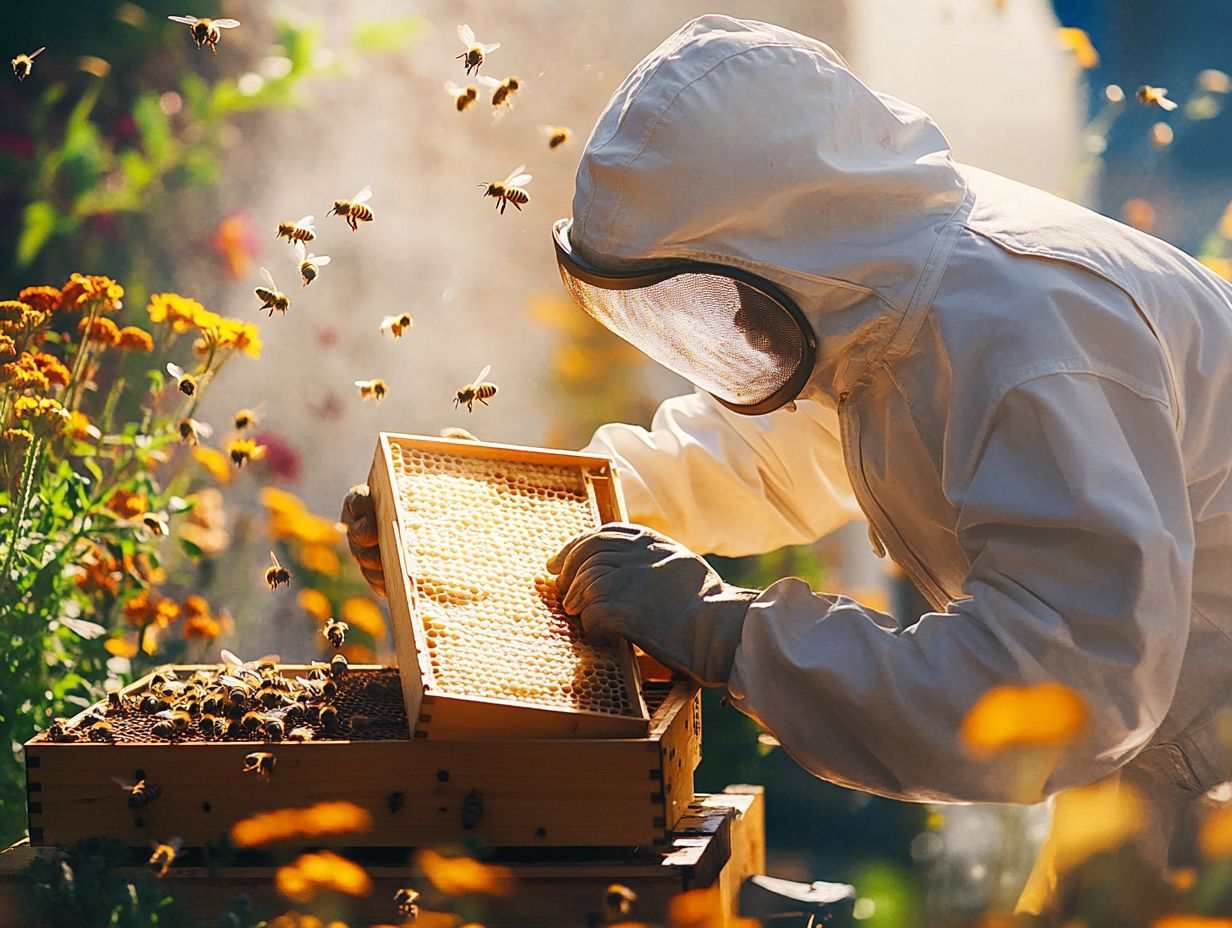
Keep your hives healthy during rotation to ensure your bee colonies flourish in their new environments and continue to produce honey efficiently. By adopting proactive measures, such as providing essential food sources and optimizing hive design, you can significantly enhance the health of your bees while minimizing potential stress during their transition.
Expert advice in beekeeping underscores the necessity of regular inspections and monitoring, enabling you to swiftly address any challenges that may arise. This is crucial for both backyard beekeeping and larger apiary setups.
Join a local beekeeping group today and take your skills to the next level!
1. Provide Adequate Food and Water
Providing adequate food and water is essential for sustaining your bee colonies during hive rotation, particularly when they’re settling into a new location. Ensuring access to essential resources like pollen patties and nectar can make a significant difference. This is especially important for backyard beekeeping setups where bees may have limited access to natural resources.
As a beekeeper, it s important for you to ensure that your hives are well-stocked with sugar syrup, honey, and pollen patties, all of which are vital for meeting the food needs of your bee colony. This can also help prevent issues like starvation and poor young bee development. Don t overlook the importance of water sources; bees need water for various hive activities, including raising young bees and metabolism.
By establishing a balanced feeding strategy, you can significantly enhance the health and productivity of your colonies. Ensure proper nutrition by supplementing with pollen patties and sugar syrup. This is vital for keeping your bees thriving throughout the seasons!
Creating sugar syrup is a breeze just mix two parts sugar with one part water to create sugar syrup. This sugary mix helps fuel your bees, especially when natural food sources are limited. Distributing this mixture in bee feeders near the hives will encourage foraging and keep your bees satisfied. Honey extraction techniques can also be used to supplement their diet, particularly in early spring.
For pollen patties, place them strategically on top of the frames to ensure easy access for your bees. In terms of providing water, shallow dishes filled with pebbles can be a safe solution, allowing bees to land without the risk of drowning. Design your hives so that bees can easily reach water sources, ensuring they stay hydrated.
Regularly monitoring your food and water levels is crucial. This is part of a comprehensive approach to apiary management that includes monitoring for pests and diseases. This approach to apiary management ensures that your bees are well-nourished and capable of maintaining their energy levels for activities like raising young bees and nectar gathering. This proactive approach helps you prevent starvation and dehydration, both critical factors in maintaining a thriving bee population during periods of transition.
Start implementing these tips today to keep your bees healthy and thriving!
2. Monitor for Pests and Diseases
Monitoring for pests and diseases is essential for maintaining the health of your hives during the rotation process. This is a fundamental aspect of beekeeping techniques that ensure the success of your beekeeping efforts. New environments can bring unexpected challenges to your bee colonies, so it’s crucial to conduct regular inspections. These inspections should include checking for issues like hive accessibility and potential environmental problems.
Look out for signs of common ailments like Varroa mites harmful parasites that can weaken bee colonies and Nosema and American Foulbrood. These can wreak havoc on your colonies if not addressed swiftly. By incorporating effective pest control measures and best practices, you can help ensure the ongoing vitality and productivity of your bee colonies throughout the rotation.
To effectively monitor these threats, pay attention to specific symptoms. For instance, a sudden drop in bee population may signal a Nosema infection, while noticing deformed bees or spotting the Varroa mites themselves could indicate a Varroa infestation. Regularly checking for unusual behavior or abnormal hive conditions can give you early warning signs, allowing you to intervene before issues escalate. Act quickly at the first sign of trouble to protect your precious bees!
Employing smart pest control methods is also key. This is part of a broader approach to livestock management that includes the health and well-being of your honey bees. Consider using natural predators, exercising caution with chemical controls, and fostering strong hive conditions through proper nutrition and genetics. This comprehensive approach will help safeguard your colonies against pests and pathogens.
Keep detailed records of your inspections to track changes and trends over time, giving you deeper insights into the health of your hives.
3. Ensure Proper Ventilation
Proper ventilation is crucial for maintaining the best conditions in your hive during the rotation process. It directly influences the health of your bees and the productivity of your colony.
When ventilation is lacking, excessive heat and moisture can accumulate inside the hive. This creates a perfect breeding ground for mold and disease. Effective hive management techniques can help prevent these issues. By implementing smart hive design choices that promote airflow, you can keep your colonies comfortable and flourishing after rotation. This is especially important for ensuring proper ventilation in backyard hives.
To facilitate adequate airflow, consider the placement of entrance holes and the overall layout of your hive. Using rotatable beehives can enhance airflow and make it easier to manage hive conditions. Adding top ventilation, such as screened or drilled holes in the hive cover, can significantly reduce heat buildup. Incorporating hive spacers allows for gaps that enable air to circulate freely without compromising the structural integrity of the interior. This can be particularly beneficial for maintaining optimal conditions during winter colony management.
During particularly humid months, ensuring that the entrance remains clear of debris and not overcrowded by bees is essential. A clear pathway encourages airflow and helps moisture escape, keeping your hive in prime condition. Proper hive entrance design can greatly facilitate this.
4. Avoid Overcrowding
Avoiding overcrowding within your hives is essential for the overall health of your bee colonies, particularly during the transition involved in hive rotation. When hives become overcrowded, stress levels increase, foraging efficiency drops, and the risk of swarming heightens. Each of these factors can jeopardize your honey production. Effective swarm prevention strategies are crucial to maintaining healthy hives.
It s important for you to implement thoughtful hive design strategies and effective management practices to ensure that your colonies have the adequate space they need to thrive.
To manage hive space effectively, regularly monitoring the growth of your bee population is crucial. Ensuring proper hive accessibility and incorporating a natural design can help accommodate colony growth. This includes keeping an eye on factors like colony growth and the presence of queen bees. This practice not only helps you anticipate the need for additional honey supers but also allows you to introduce extra brood boxes (where the bees raise their young) when necessary.
Installing more honey supers before the nectar flow season is essential to ensure your bees can thrive and store honey without feeling cramped. Keeping an eye on the frames for signs of congestion or queen cells will enable you to make timely decisions about hive expansion, thereby maintaining a balanced and productive environment for your bees. This is vital for both backyard beekeepers and commercial operations eager to keep their colonies thriving. Hive accessibility is important, as easy access to brood boxes and honey supers can facilitate better management.
What Are The Alternatives To Hive Rotation?
While hive rotation certainly stands out as a favored technique for improving bee colony health and boosting honey production, you might also consider several alternatives that can enhance your apiary management strategy and address various beekeeping challenges.
For example, splitting hives can not only foster the creation of new colonies but also encourage colony growth within existing ones, all while mitigating the risk of swarming.
Relocating hives based on environmental conditions can help maximize nectar gathering opportunities and address environmental issues, eliminating the necessity for conventional rotation methods.
1. Splitting Your Hives
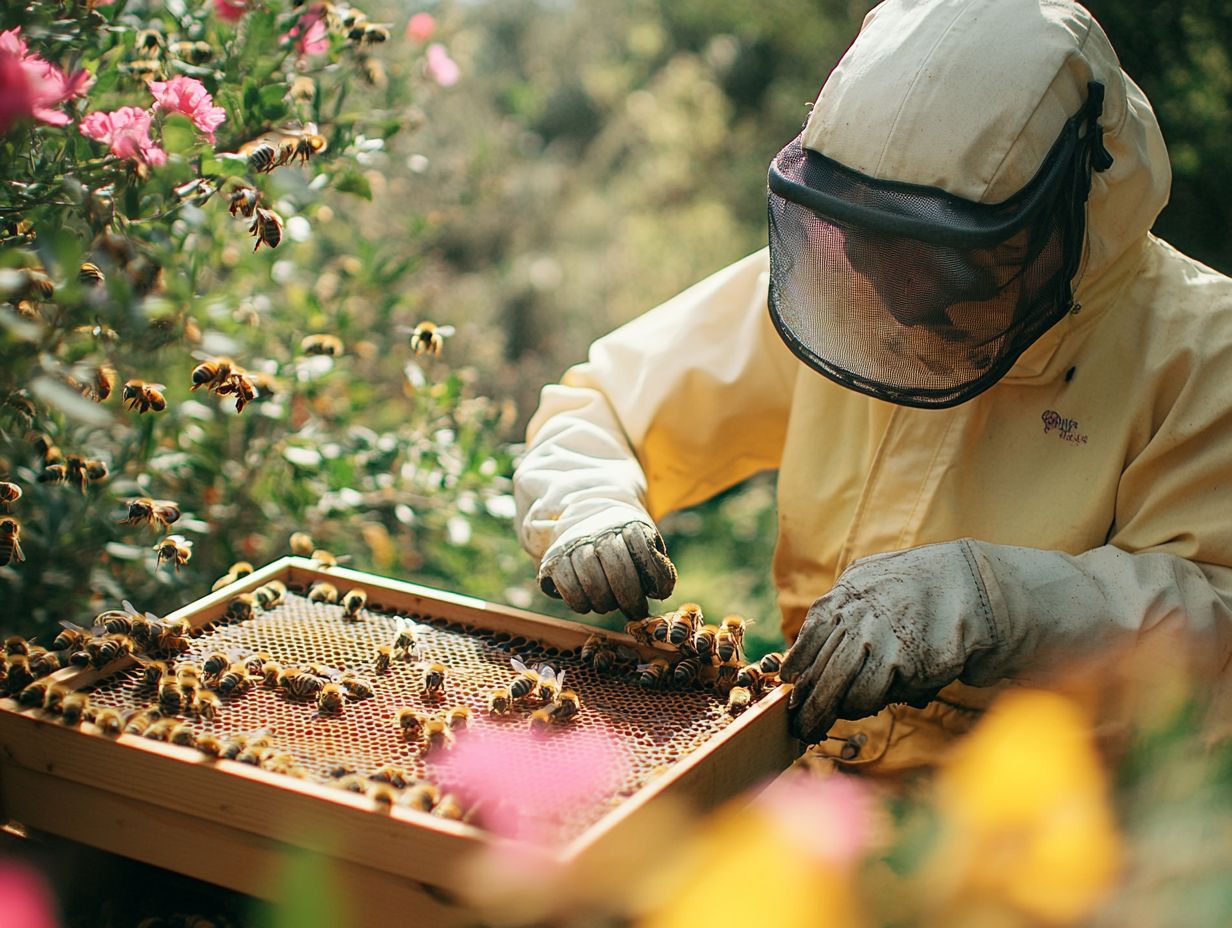
Splitting your hives presents a sophisticated alternative to traditional hive rotation. This exciting technique involves dividing an existing hive to establish a new colony, enabling you to manage bee colonies proactively while effectively preventing swarming. By meticulously managing the split, you can maintain the strength of each colony and optimize honey production across your apiaries.
Using the right beekeeping equipment, such as brood boxes (containers for raising bee larvae) and honey supers (containers for collecting honey), can greatly improve the success of this technique. To execute a successful hive split, timing is everything; aim for spring when your colony is at its peak strength. Best practices dictate that you choose a well-populated hive and ensure both split groups are well-resourced, with ample brood, nectar, and pollen.
By leaving a sufficient number of foragers with each segment of the split, you significantly enhance their chances of thriving. Engaging with the beekeeping community for beekeeping advice can also provide valuable insights.
By adopting this method, you not only reduce the risk of swarming but also bolster your capacity to manage colonies more effectively. This paves the way for increased honey yields throughout the season. It s also important to educate bee enthusiasts and participate in beekeeping education programs to stay updated with the latest techniques.
2. Moving Hives to New Locations
Moving hives to new locations presents a compelling alternative to traditional hive rotation. This approach allows you to take full advantage of optimal nectar-gathering conditions without the meticulous process of rotating hives. It can be particularly advantageous during peak flowering seasons when certain areas offer richer foraging opportunities for your honey bees.
By strategically relocating your hives, you can boost honey production while ensuring that your colonies remain healthy and well-fed. Joining a local bee club can offer additional support and knowledge for successful hive relocation.
When contemplating such a move, it’s essential to give careful thought to the logistics. Environmental conditions such as temperature and wind patterns can significantly impact bee behavior and hive stability. Accessibility is crucial; the site you choose should facilitate easy transport and regular monitoring without causing undue disturbance to the bees.
Prioritizing the safety of your bees during the transition is vital to prevent unnecessary stress on the colonies. Ensuring easy hive accessibility and following safe bee handling practices is key to a smooth transition.
To identify the ideal location, you should delve into research on seasonal nectar flows and consider the proximity to various flowering plants. This will help ensure a thriving environment for your bees as they acclimate to their new home. Consulting resources from Honey Bee Suite or Long Lane Honey Bee Farms can provide expert recommendations.
Frequently Asked Questions
What is hive rotation?
Hive rotation is the process of moving beehives from one location to another to provide the bees with better foraging opportunities and to prevent overgrazing of resources in a particular area. Some advanced hive designs, like the Appalachian Rotatable Beehive, can facilitate this process.
Why is hive rotation important?
Hive rotation is crucial! It gives bees access to a variety of nectar and pollen sources, leading to a healthier and more diverse diet. It also helps to prevent overcrowding in a specific area and reduces the risk of disease spread among colonies. Engaging with community feedback and staying updated with beekeeping techniques can further enhance the success of hive rotation.
When is the best time to rotate hives?
The best time to rotate hives is typically in the spring or fall when nectar sources are more abundant and the weather is mild. However, it can also be done during the summer months if necessary.
How often should hives be rotated?
Hives should be rotated at least once a year, preferably twice, to allow bees to access different foraging areas and to reduce the risk of overgrazing and depletion of resources. However, the frequency of rotation can vary depending on the specific needs of the bees and the environment.
Join your local beekeeping community today for more helpful tips!
What are some tips for successful hive rotation?
Select a new location with plenty of food sources. Ensure the new site is sheltered from harsh weather conditions.
Gradually move the hives to help the bees adapt. Using seasonal management techniques and conducting regular hive inspections also boosts hive rotation success.
How can hive rotation benefit bees and beekeepers?
Absolutely! Hive rotation is a game-changer for both bees and beekeepers.
For bees, it offers diverse and nutritious food sources, leading to stronger, healthier colonies.
For beekeepers, it can increase honey production and lower the risk of disease and swarming.
Backyard beekeeping can further enhance the benefits of hive rotation!

